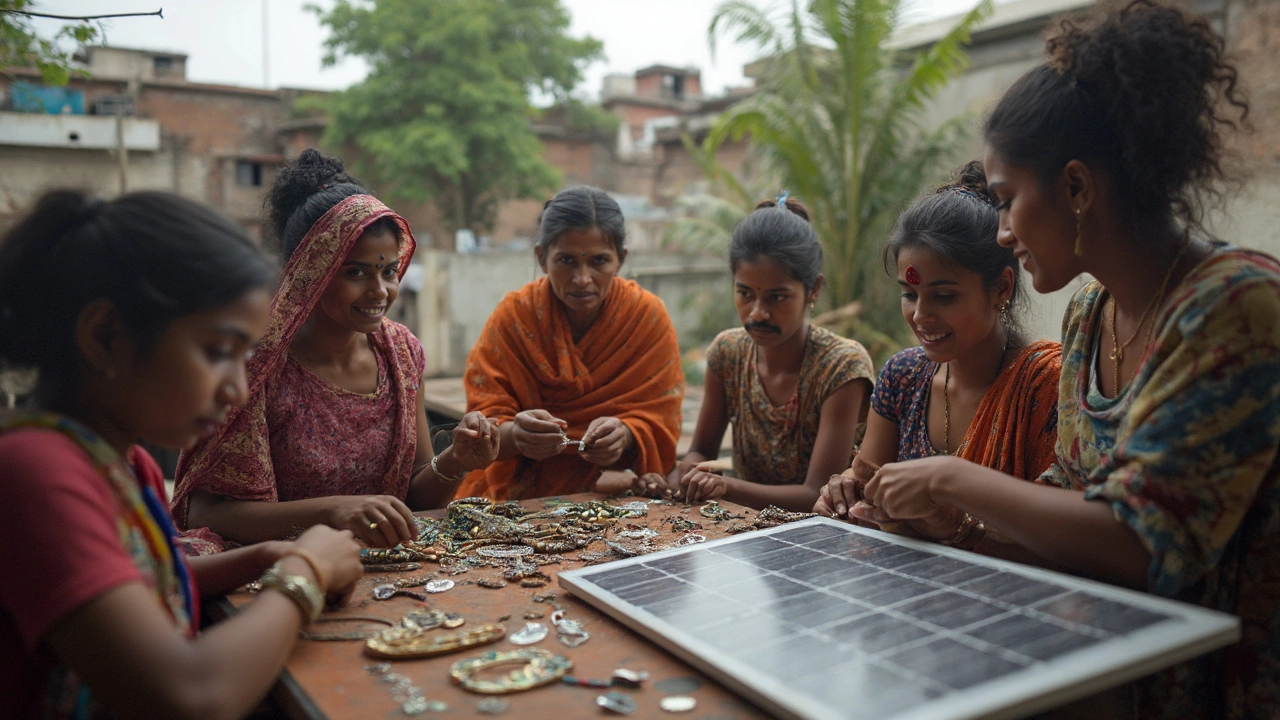
If you ever wondered what vocational activities really are, think about the kind of hands-on work that teaches you something useful—like fixing a motorbike, running a beauty salon, or baking bread. They're not just about sitting in a classroom. You actually learn by doing stuff that can help you get a job later on. That’s the real trick: vocational activities take you out of theory and throw you straight into tasks you’ll face in the real world.
This is especially big for women looking to pick up skills that line up with real jobs—things that actually pay the bills. Want to learn tailoring to open your own boutique, or master computers for an office career? Vocational activities break down that huge wall between what’s taught on paper and what’s needed outside. The best part? You don’t need a fancy degree to start. Many centers and trainers focus on
- What Are Vocational Activities?
- Why Vocational Skills Matter for Women
- Everyday Examples of Vocational Activities
- Finding the Right Vocational Program
- Tips to Maximize the Benefits
What Are Vocational Activities?
Vocational activities are hands-on jobs or tasks that teach you real skills you can use at work. Instead of just reading about something, you actually do it. For a lot of women, this is a way to get practical knowledge, and sometimes even earn while learning. Think of it as “learning by doing” with one clear goal: get better at a job or start a business.
These activities aren’t limited to any one field. You’ll find vocational courses in areas like tailoring, computer basics, nursing support, driving, carpentry, office management, and even smartphone repair. The idea is simple—give people skills that employers are looking for, or that let you start your own thing.
One of the most important things about vocational activities is that anyone can join, no fancy degrees needed. In India, for example, a 2023 government report showed over 42% of women who completed short-term vocational courses (lasting 3 to 6 months) found jobs faster than those with only regular schooling. That’s a huge jump, and it’s all because these activities focus on what’s actually needed in the job market.
Here’s why people talk so much about vocational activities:
- Training is very focused—right away, you learn things you actually use on a job.
- You don’t waste time with lessons you don’t need; it’s all practical and straight to the point.
- Courses are often shorter, which means you can finish and get to work sooner.
Check out this breakdown of some top vocational areas for women in India, as of 2024:
| Vocational Activity | Typical Course Duration | Starting Salary (per month, INR) |
|---|---|---|
| Beauty & Wellness | 3-6 months | 8,000 - 15,000 |
| Tally (Accounting Software) | 2-4 months | 10,000 - 18,000 |
| Tailoring | 4-6 months | 7,000 - 15,000 |
| Office Administration | 3-6 months | 10,000 - 16,000 |
| Home Nursing | 6-9 months | 12,000 - 22,000 |
If you’re wondering if vocational activities are too basic, think again. Many top companies actually prefer candidates who have this type of training because they’re job-ready from day one. So, if you’re tired of theory and want to build real, marketable skills quickly, this is where to start.
Why Vocational Skills Matter for Women
Skills you actually use on the job are game-changers, and that's where vocational activities come in. For women, these skills unlock more freedom to choose the work they want. They can start a business, improve family income, or get jobs outside the home. In India alone, vocational skills have helped millions of women move from unpaid household tasks into paid work—which is a big shift.
Fact: In 2024, the Ministry of Skill Development & Entrepreneurship reported that women made up almost 40% of all trainees in government vocational programs. That's double the percentage from a decade ago. It’s not just about numbers either. Women who get skilled training earn, on average, 35% more compared to those with no practical skills.
Here's a quick look at how vocational training impacts women:
| Benefit | Impact for Women |
|---|---|
| Better Job Prospects | Access to higher-paying, steady jobs |
| Business Opportunities | Start stalls, shops, or home-services businesses |
| Confidence | Decide on their own career and finances |
| Work Flexibility | Part-time or self-employment options |
It’s also about respect and voice. Studies by Pratham and Azim Premji Foundation show that women with technical or trade skills are much more likely to join small businesses or set up their own. Many training programs even offer childcare or classes after hours, so more women—especially young mothers—can join without extra stress.
When women pick up skills that match real jobs, entire families benefit. Kids see their mothers earning and feel proud; neighborhoods also get new services—from tailoring to mobile repair—even in smaller towns. That’s a ripple effect you don't want to ignore.

Everyday Examples of Vocational Activities
When you hear about vocational activities, it’s not just about welding metal or building furniture. For women especially, there’s a huge range of options that connect directly with jobs found in most towns and cities. These are skills you see making a real difference every day.
Here are several practical examples that are common across India and other countries:
- Tailoring and Fashion Design — Easily one of the top picks for women. You can start small from home, upgrade your skills later, and even run your own boutique.
- Beauty and Wellness — Think makeup, hair styling, spa treatments. After basic training, getting work in salons or starting a home-based service is totally doable.
- Baking and Cooking — Professional kitchen skills are in demand. Whether it’s running a bakery counter or catering from home, women are leading the charge here.
- Basic Computer Skills — From using spreadsheets to designing digital flyers, these courses are a launchpad to various office jobs or freelancing gigs.
- Nursing and Elderly Care — With the population getting older, there’s a real need for women with certified training in health care, whether at hospitals or as private caregivers.
Plenty of NGOs and government programs focus specifically on women’s skill development. For example, the Pradhan Mantri Kaushal Vikas Yojana has trained over 40 lakh women in India, with tailoring, beauty, and IT as the biggest draws. Check out this data from last year:
| Vocational Field | Women Trained (2024) |
|---|---|
| Tailoring & Fashion | 1,200,000 |
| Beauty & Wellness | 890,000 |
| Cooking & Baking | 650,000 |
| Computer Skills | 580,000 |
| Health Care | 430,000 |
The best thing about these activities—they don’t lock you into one line of work forever. Once you’ve learned the basics, you can always switch things up, add new skills, or grow your own business. Lots of women start with short-term courses and end up turning their skills into side hustles or full-time ventures. Real stuff, real results.
Finding the Right Vocational Program
Choosing a good vocational program can feel a bit overwhelming with so many options out there. But honestly, you just need to know what boxes to tick. First, see if the program gives you skills that are actually in demand where you live. For example, IT support and digital marketing courses are popular in cities, while tailoring or handicrafts might be bigger in smaller towns. The Indian government's Skill India portal lists hundreds of certified centers—it’s a great place to start your search.
Next, check if the training center or course is officially recognized. Many women have wasted months on courses that give fancy certificates but are not respected by employers. Always look for programs approved by NSDC (National Skill Development Corporation) or state skills missions. As Deeksha Pande, a well-known skills trainer from Bengaluru, points out:
"A recognized certificate opens doors. But the real value is in the skills you can show on the job, so choose a place that puts you to work, not just through PowerPoint slides."
Here are a few things to look for when picking a training program:
- Does it offer real practice, or is it just theory?
- What is the trainer’s experience? You want someone who’s worked in the actual field.
- Do they help you get a job or an internship after training?
- Is the timing flexible enough for family or other work commitments?
Many women have found success by talking to people already working in the trade. Don’t be shy—call up local business owners or alumni. A quick chat often gives more insight than a brochure.
Above all, focus on one main thing: practical learning. Whether you’re interested in fashion design, computer skills, or any other vocational activities, the value comes from what you can actually do when the training is over. That’s what employers and customers care about.

Tips to Maximize the Benefits
Getting the most out of vocational activities isn’t just about signing up for a course. There’s more you can do to make sure all that effort turns into new opportunities, higher pay, or even your own small business.
Here’s what actually works—based on what trainers recommend and what I’ve seen with women around me, including Nalini.
- Set clear goals from the start. Ask yourself why you’re taking this up. Is it to snag a new job, get promoted, or just earn a steady income from home? Knowing the end goal helps you pick the right program and keeps you motivated.
- Take advantage of hands-on practice. The magic of vocational training lies in doing, not just listening. Try to get as much real-world practice as you can—look for programs that offer internships or real projects. For instance, some tailoring centers let you design and sell your own creations before the course wraps up.
- Build your network. Don’t just disappear after class. Chat with trainers, connect with classmates, or join WhatsApp groups. These connections often lead to job openings, side gigs, or even business partnerships.
- Keep learning after your course ends. Skills change fast, especially in tech or beauty fields. Watch tutorial videos online, join Facebook groups, or attend workshops to stay sharp or add new tricks. Some government programs, like India’s PMKVY, offer refresher courses or online certifications for free.
- Showcase your results. Put together a portfolio—even if it’s just photos on your phone—of your work. If you’re in baking, share pictures of your best cakes. If you’re in computers, make a simple website. This not only shows off your skill but helps with job interviews or finding customers.
Above all, don’t shy away from asking questions while learning. Trainers say the women who speak up usually learn the most and end up landing the best gigs. Grab every small chance to practice and learn, even outside class—turning skills into confidence is what opens real doors.
